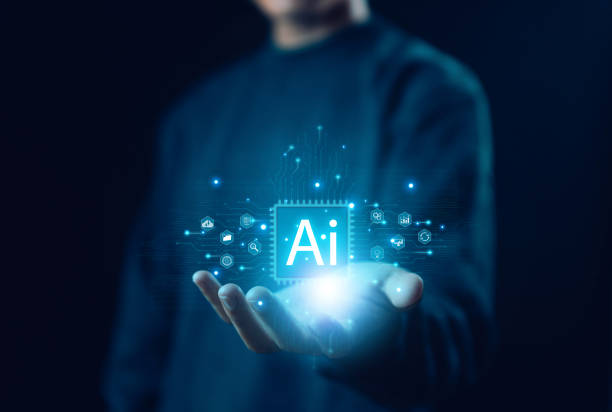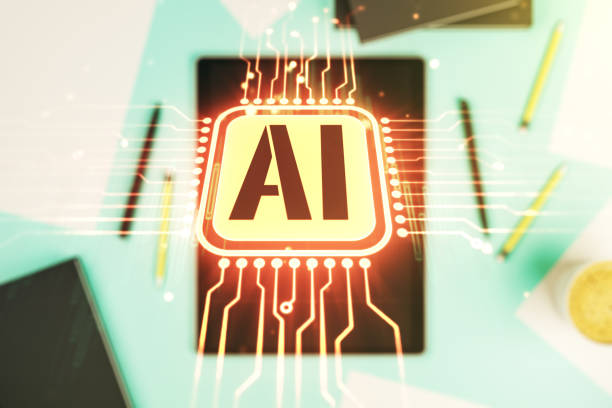What is Artificial Intelligence? Definitions and Basic Concepts

#Artificial_Intelligence (AI) is a branch of computer science that deals with building intelligent machines capable of performing tasks that usually require human intelligence.
These tasks include learning, reasoning, problem-solving, understanding natural language, and pattern recognition.
Artificial intelligence strives to create systems that can think, learn, and act like humans.
Generally, artificial intelligence is divided into two main categories: Narrow AI and General AI.
Narrow AI is designed to perform a specific task and performs excellently in its limited domain.
Examples of narrow AI include voice assistants like Siri and Alexa, movie recommendation systems on Netflix, and self-driving cars.
In contrast, General AI refers to a system that can successfully perform any intellectual task a human can.
General AI is still in theoretical stages and has not been fully realized.
Key concepts in artificial intelligence include Machine Learning (Machine Learning), Deep Learning, Natural Language Processing (NLP), and Computer Vision.
Each of these fields plays an important role in the development and advancement of artificial intelligence, enabling machines to interact with the world around them and perform more complex tasks.
The ultimate goal of artificial intelligence is to create systems that are not only capable of performing specific tasks but can also adapt to environmental changes, learn from their experiences, and make intelligent decisions.
This can lead to widespread transformations in various industries and our daily lives.
Did you know that 94% of users’ first impressions of a business are related to its website design? Turn this first impression into an opportunity for growth with professional corporate website design by **RasaWeb**.
✅ Attract more customers and increase sales
✅ Build credibility and trust in the eyes of the audience⚡ Get a free website design consultation!
History and Evolution of Artificial Intelligence

The history of artificial intelligence dates back to the 1950s, when scientists and researchers began exploring the possibility of building machines that could think like humans.
The term “Artificial Intelligence” was coined in 1956 at a conference at Dartmouth College.
In the early decades, advancements in this field were mostly theoretical and limited to symbolic programming.
In the 1960s and 1970s, AI faced periods of stagnation and disappointment.
A lack of computational power and algorithmic limitations meant that many projects did not achieve their goals.
However, this period also saw advancements in areas such as expert systems and natural language processing.
In the 1980s, with the emergence of more powerful computers and new algorithms, AI once again gained attention.
Machine learning, especially neural networks, emerged as a promising approach to solving complex problems.
This period saw the development of commercial expert systems and industrial applications of AI.
The 2000s were accompanied by significant advancements in deep learning and access to Big Data.
Deep learning algorithms, especially deep neural networks, achieved unprecedented results in fields such as computer vision and natural language processing.
These advancements led to the development of new applications such as self-driving cars, intelligent voice assistants, and recommendation systems.
Today, artificial intelligence has become one of the leading fields in technology and has widespread applications in various industries.
With continued advancements in algorithms, hardware, and data access, AI is expected to play a more significant role in our lives in the future.
Applications of Artificial Intelligence in Various Industries

Artificial intelligence currently has widespread applications in various industries and helps improve efficiency, reduce costs, and create new innovations.
Here are some of the key applications of artificial intelligence in different industries:
Healthcare: AI is used in disease diagnosis, drug development, personalized treatments, and hospital management.
Machine learning algorithms can analyze medical images and detect patterns that are not visible to doctors.
Additionally, AI can help develop new drugs with greater speed and accuracy.
Finance and Banking: In this industry, AI is used in fraud detection, risk management, customer service, and algorithmic trading.
Machine learning algorithms can identify suspicious patterns in financial transactions and prevent fraud.
Additionally, AI-powered chatbots and virtual assistants can help customers with banking tasks.
Manufacturing: AI is used in automating production processes, quality control, predicting equipment failures, and optimizing the supply chain.
Intelligent robots and computer vision systems can perform repetitive and dangerous tasks on production lines.
Additionally, AI can analyze sensor data and predict equipment failures to prevent production shutdowns.
Retail: In this industry, AI is used in product recommenders, inventory management, customer behavior analysis, and providing personalized services.
Machine learning algorithms can analyze customer tastes and preferences and suggest suitable products to them.
Additionally, AI can help optimize inventory management and reduce costs.
Transportation: AI is used in the development of self-driving cars, route optimization, traffic management, and improving transportation safety.
Self-driving cars use computer vision and deep learning algorithms to understand their surroundings and make appropriate decisions.
Additionally, AI can help manage traffic and reduce travel time.
In addition to these industries, AI has widespread applications in other fields such as education, agriculture, energy, and entertainment, helping to improve performance and innovation in these areas.
These are just some examples of the broad applications of artificial intelligence, and with technological advancements, new applications are expected to be developed in the future.
| Industry | Applications |
|---|---|
| Healthcare | Disease diagnosis, drug development |
| Finance and Banking | Fraud detection, risk management |
| Manufacturing | Process automation, quality control |
Machine Learning and Key Algorithms

Machine Learning is a major subfield of artificial intelligence that enables machines to learn from data without explicit programming.
Machine learning algorithms identify patterns and relationships in data by analyzing them and use these patterns to predict or make decisions about new data.
Machine learning is generally divided into three main categories:
Supervised Learning: In this type of learning, the algorithm is trained using labeled data.
Labeled data includes inputs and desired outputs.
The algorithm’s goal is to learn a function that can map inputs to correct outputs.
Examples of supervised learning algorithms include linear regression, logistic regression, decision trees, and Support Vector Machines (SVM).
Unsupervised Learning: In this type of learning, the algorithm is trained using unlabeled data.
The algorithm’s goal is to discover hidden patterns and structures in the data.
Examples of unsupervised learning algorithms include Clustering, Dimensionality Reduction, and Principal Component Analysis (PCA).
Reinforcement Learning: In this type of learning, the algorithm is trained by interacting with an environment and receiving rewards or penalties.
The algorithm’s goal is to learn a policy that can maximize rewards over time.
Examples of reinforcement learning algorithms include Q-learning and Deep Q-Network (DQN).
Key algorithms in machine learning include Neural Networks, Decision Trees, Support Vector Machines, Linear Regression, and Clustering Algorithms.
Each of these algorithms has its own specific features and applications and can be used to solve different problems depending on the type of problem and data.
Tired of missing business opportunities due to not having a professional corporate website? Don’t worry anymore! With RasaWeb’s professional corporate website design services:
✅ Your brand’s credibility and professionalism will increase significantly.
✅ You will attract more customers and sales leads.
⚡ Get a free consultation now to start!
Deep Learning and Neural Networks

Deep Learning is a subfield of machine learning that uses deep neural networks to learn from data.
Deep neural networks consist of multiple layers of computational nodes (neurons) that are hierarchically connected.
This structure enables networks to identify complex and abstract patterns in data.
Deep neural networks have achieved excellent results in various fields such as computer vision, natural language processing, and speech recognition.
Examples of deep neural networks include Convolutional Neural Networks (CNNs) for image processing, Recurrent Neural Networks (RNNs) for processing sequential data like text and speech, and Transformers for natural language processing.
The training process of deep neural networks is usually performed using optimization algorithms such as Gradient Descent.
In this process, network weights are iteratively adjusted to reduce the error between predicted and actual outputs.
Training deep neural networks requires large datasets and significant computational power.
One of the main advantages of deep learning is its ability to automatically extract important features from data.
In traditional machine learning methods, engineers had to manually design features for each problem.
But in deep learning, networks can automatically learn appropriate features from the data.
This makes deep learning very suitable for solving complex and diverse problems.
Natural Language Processing (NLP)

Natural Language Processing (NLP) is a branch of artificial intelligence that enables machines to understand, interpret, and generate human language.
NLP includes a set of techniques and algorithms that are used for analyzing and processing text and speech.
NLP applications are very broad and include machine translation, text summarization, sentiment analysis, question answering, chatbots, and text analysis.
In machine translation, NLP systems can translate text from one language to another.
In text summarization, NLP systems can generate a summary of a long text.
In sentiment analysis, NLP systems can identify the emotions present in a text.
One of the main challenges in NLP is the ambiguity of human language.
Human language can be very complex and ambiguous, and a word or phrase can have different meanings.
To solve this challenge, NLP systems use various techniques such as syntactic analysis, semantic analysis, and contextual analysis.
One of the important advancements in NLP is the use of deep neural networks, especially transformer networks.
Transformer networks have achieved excellent results in various NLP fields and are widely used in machine translation, text summarization, and question-answering systems.
NLP plays an important role in the development of intelligent voice assistants like Siri and Alexa.
These assistants use NLP to understand user voice commands and provide appropriate responses.
Additionally, NLP is used in chatbot systems to provide customer service and answer user questions.
These are examples of AI applications that are widely used.
Computer Vision

Computer Vision is a branch of artificial intelligence that enables machines to understand and interpret images and videos.
Computer Vision includes a set of techniques and algorithms that are used for image analysis, object detection, face recognition, motion tracking, and 3D scene reconstruction.
Computer Vision applications are very broad and include self-driving cars, video surveillance systems, medical diagnosis, robotics, and augmented reality.
In self-driving cars, computer vision systems are used to detect objects such as vehicles, pedestrians, and traffic signs.
In video surveillance systems, computer vision systems are used to detect suspicious activities and alert operators.
One of the main challenges in computer vision is the wide variety of images and videos.
Images and videos can be affected by various factors such as lighting, viewing angle, size, and position of objects.
To solve this challenge, computer vision systems use various techniques such as machine learning, deep learning, and image processing.
One of the important advancements in computer vision is the use of Convolutional Neural Networks (CNNs).
CNNs have achieved excellent results in various computer vision fields and are widely used in object detection, face recognition, and motion tracking systems.
Computer Vision plays an important role in the development of intelligent robots.
Intelligent robots use computer vision to understand their surroundings and perform various tasks.
Additionally, computer Vision is used in augmented reality systems to add virtual information and objects to the real world.
| Application | Description |
|---|---|
| Self-driving cars | Detection of objects and traffic signs |
| Video surveillance systems | Detection of suspicious activities |
| Medical diagnosis | Analyzing medical images for disease diagnosis |
Challenges and Limitations of Artificial Intelligence

Despite significant advancements, artificial intelligence still faces numerous challenges and limitations.
One of the main challenges is the need for large and high-quality data to train machine learning algorithms.
Machine learning algorithms require a lot of data to learn patterns and relationships within the data.
If the data is scarce or of poor quality, the performance of the algorithms significantly decreases.
Another challenge is the interpretability of machine learning algorithms.
Many machine learning algorithms, especially deep neural networks, act as black boxes.
This means that understanding why an algorithm made a specific decision is difficult.
This can create problems in fields such as medicine and law, where explanations for decision-making are required.
Another challenge is the generalizability of machine learning algorithms.
Machine learning algorithms are typically trained for a specific domain and may not perform well in other domains.
To solve this challenge, there is a need to develop algorithms that can automatically generalize to new domains.
Another limitation is the ethical concerns related to artificial intelligence.
AI can be used for malicious purposes such as building autonomous weapons, monitoring individuals, and discriminating against specific groups.
To prevent these problems, there is a need to develop ethical and legal frameworks for AI.
In addition to these challenges, AI still faces limitations in understanding human language, reasoning, and solving complex problems.
To address these limitations, further research and the development of new algorithms are needed.
AI is still in its early stages of development, and with technological advancements, many of these challenges and limitations are expected to be overcome.
Despite all its advantages, artificial intelligence also carries risks that need to be considered.
Does your current corporate website present a worthy image of your brand and attract new customers?
If not, turn this challenge into an opportunity with RasaWeb’s professional corporate website design services.
✅ Significantly improve your brand’s credibility and image.
✅ Pave the way for attracting new leads and customers.
⚡ Contact RasaWeb now for a free and specialized consultation!
The Future of Artificial Intelligence and Upcoming Trends

The future of artificial intelligence is very bright and full of new opportunities.
With continued advancements in algorithms, hardware, and data access, AI is expected to play a more significant role in our lives in the coming years.
Some of the upcoming trends in artificial intelligence include:
Explainable AI (XAI): With the increasing use of AI in sensitive areas, the need for algorithms that can explain their decision-making processes becomes more critical.
XAI focuses on developing algorithms that are understandable and reliable.
Edge AI: With the growing number of internet-connected devices, the need for processing data at the edge of the network (close to the data source) increases.
Edge AI focuses on developing algorithms that can run on small, low-power devices.
AutoML: As machine learning algorithms become more complex, the need for tools that can automatically find the best algorithm and parameters for a specific problem becomes more important.
AutoML focuses on developing these tools.
Ethical AI: With increasing ethical concerns related to AI, the need to develop ethical and legal frameworks for AI becomes more critical.
Ethical AI focuses on developing these frameworks.
Artificial General Intelligence (AGI): AGI focuses on developing systems that can successfully perform any intellectual task a human can.
AGI is still in theoretical stages, but research in this area continues.
In the future, AI is expected to bring widespread transformations in various fields such as healthcare, finance and banking, manufacturing, retail, transportation, education, agriculture, energy, and entertainment.
AI can help improve efficiency, reduce costs, increase safety, and create new innovations.
However, to fully utilize the potential of AI, it is necessary to address existing challenges and limitations and develop appropriate ethical and legal frameworks.
Many efforts have been made for the advancement of AI.
Artificial intelligence will come to our aid
How to Get Started with Artificial Intelligence?

Starting with artificial intelligence can be an exciting and rewarding experience.
To begin, you can follow these steps:
Learn Basic Concepts: First, you need to become familiar with the basic concepts of artificial intelligence, machine learning, deep learning, natural language processing, and computer vision.
There are many online learning resources you can use, such as courses on Coursera, edX, and Udacity.
Choose a Programming Language: To work with AI, you need to learn a programming language.
Python is one of the most popular programming languages for AI and has many libraries for machine learning and deep learning.
Other languages like R and Java can also be used for AI.
Use Libraries and Frameworks: Many libraries and frameworks exist for machine learning and deep learning that you can use.
Some of the most popular libraries and frameworks include TensorFlow, PyTorch, scikit-learn, and Keras.
Do Practical Projects: The best way to learn AI is by doing practical projects.
You can start with simple projects such as image recognition, stock price prediction, and sentiment analysis, and gradually move on to more complex projects.
Join Online Communities: There are many online communities for AI that you can join and connect with other AI enthusiasts.
These communities can help you learn new concepts, solve problems, and find job opportunities.
Study New Articles and Research: AI is an evolving field, and new articles and research are published daily.
To stay up-to-date with the latest advancements, you should regularly study new articles and research.
By following these steps, you can gradually acquire the necessary knowledge and skills to work with AI and succeed in this field.
Don’t forget that learning AI requires patience, perseverance, and continuous practice.
Artificial intelligence will build a new world for you
Frequently Asked Questions
| Question | Answer |
|---|---|
| What is the definition of Artificial Intelligence (AI)? | It is a field in computer science that aims to create intelligent machines capable of thinking, learning, problem-solving, and making decisions like humans. |
| Mention some common applications of Artificial Intelligence. | These include self-driving cars, voice assistants (like Siri and Alexa), recommendation systems (like Netflix and Amazon), face recognition, and medical diagnosis. |
| What is the difference between Narrow AI (ANI) and General AI (AGI)? | Narrow AI is specialized in one specific task, while General AI possesses human intellectual ability to perform any cognitive task. |
| What is Machine Learning and its relationship to Artificial Intelligence? | Machine Learning is a branch of Artificial Intelligence that focuses on developing algorithms that allow systems to learn from data without explicit programming. |
| What are Artificial Neural Networks? | They are computational models inspired by the structure and function of the human brain, used in deep learning to process data and discover complex patterns. |
| Mention some ethical challenges related to Artificial Intelligence. | These include privacy issues, bias in data and algorithms, job displacement, and accountability in case of errors or unfair decisions. |
| What is Natural Language Processing (NLP)? | It is a branch of Artificial Intelligence that focuses on enabling computers to understand, interpret, and generate human language in a useful and interactive way. |
| How can Artificial Intelligence affect the job market? | It can lead to the automation of some routine tasks, requiring retraining of workers and creating new jobs in the fields of designing, developing, and maintaining AI systems. |
| What is Computer Vision? | It is a field in Artificial Intelligence that enables computers to “see,” understand, and interpret images and videos in the same way humans do, allowing them to recognize objects and faces. |
| What is the importance of data in developing AI systems? | Data is the fuel that powers AI systems, especially in machine learning. The quality and quantity of data significantly affect the accuracy and performance of models and their ability to learn and make correct decisions. |
And other advertising agency RasaWeb services in the field of advertising
- Intelligent Customer Journey Map: Designed for businesses seeking to manage campaigns through SEO-driven content strategy.
- Intelligent Sales Automation: An innovative platform for improving customer behavior analysis with precise audience targeting.
- Intelligent Link Building: A professional solution for increasing website traffic with a focus on customizing user experience.
- Intelligent UI/UX: An innovative platform for improving SEO ranking by customizing user experience.
- Intelligent SEO: An effective tool for user engagement with attractive UI design.
And hundreds of other services in the field of internet advertising, advertising consultation, and organizational solutions
Internet Advertising | Advertising Strategy | Advertorial
Resources
What is AI? A Complete Guide
New Applications of AI in Industry
Research Articles on Artificial Intelligence
The Future of AI and Upcoming Challenges
? For a big leap in your business and reaching the pinnacle of success, Rasaweb Afarin Digital Marketing Agency is by your side with its specialized services. Get a powerful online presence now with fast and professional website design.
📍 Tehran, Mirdamad Street, next to Bank Markazi, Southern Kazeroon Alley, Ramin Alley, No. 6



